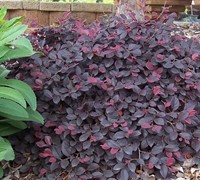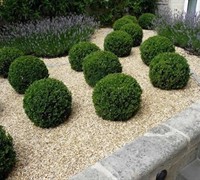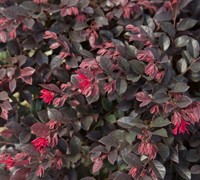USDA Plant Hardiness Zone Map
What is a USDA Hardiness Zone? Why Does It Matter?
Hardiness zones were determined by the United States Department of Agriculture (USDA) to help gardeners and growers determine which plants are most likely to thrive in a particular location.
The zones are based on an area's average annual minimum winter temperature. Colder zones have lowers numbers, and warmer areas have higher numbers. The whole numbers (1, 2, 3, etc.) represent areas that differ by 10 degrees Fahreinheit. The subzones ("a" and "b") represent a 5-degree Fahreinheit variance.
The USDA map is the most frequently used guide for determining if a plant will grow successfully in a particular area. It is used by most gardeners, gardening magazines, catalogs, books, websites, and nureries.
Important Limitations To Consider
However, the USDA zone system is not infallible. As it is based only on average annual extreme minimum winter temperatures, it does not account for variations in other climatic conditions. For optimial plant survival, a gardener needs to also consider other climatic factors such as humidity, precipitation levels, storms, and cycles of wet/dry weather. Zones also do not factor in other winter factors such as frost dates and the frequency and amount of snow cover. For example, snow can be an insulator against extreme cold, and so areas with higher levels of snowfall can actually provide more protection to the roots of a plant.
Zones also do not take into account the day length of the various seasons. Some plants may survive and grow, but will not flower if the length of daylight is insufficient. Other plants may need a particular duration of cold weather (called vernalization) in order to flower the following season. In essence, the USDA zone system can help to determine the survivability of a plant, but may not represent optimal growing conditions for a plant.
Plants also vary greatly in their needs for a particular type of soil, optimal soil drainage, sun exposure, and soil pH. Here at ToGoGarden, we provide you with the optimal needs for each plant we sell. Use the USDA zones to narrow down plants that are suitable for your area, but also thoroughly research the individual needs of a plant before purchasing and planting to see if you have just the right spot for it in your garden!
USDA Plant Hardiness Zone Map
Each USDA Zone has a number and color code. Find your location on the map below and then note the corresponding color and zone number.

Zone Descriptions
USDA Zone descriptions are based on the average minimum temperature experienced in a particular region/zone.
Zone 2B · -45° to -40° F
Zone 2b has a low temperature of -45 to -40 Fahrenheit and -40 to -42.7 Celsius, spanning from interior areas of Alaska (Unalakleet), the northernmost tip of Minnesota, middle regions of Canada, and northernmost regions of China.
Zone 3A · -40° to -35° F
Zone 3a has a low temperature of -40 to -35 Fahrenheit and -37.3 to -39.9 Celsius, spanning from northernmost regions of Minnesota (International Falls), interior and northern coastal areas of Alaska (St. Michael), southern regions of Canada, northern regions of Europe, northern regions of China, and central regions of northern Japan.
Zone 3B · -35° to -30° F
Zone 3b has a low temperature of -35 to -30 Fahrenheit and -34.5 to -37.2 Celsius, spanning from northernmost regions of the US, interior and northern coastal areas of Alaska, southern regions of Canada, northern areas of Europe, some central and northern interior regions of China, and interior regions of northern Japan.
Zone 4A · -30° to -25° F
Zone 4a has a low temperature of -30 to -25 Fahrenheit and -31.7 to -34.4 Celsius, spanning from northern regions in the Midwest and northeast US, western coastal areas of Alaska, coastal regions of eastern Canada, northern areas of Europe, some central and northern interior regions of China, isolated areas of South America, and northern regions of Japan.
Zone 4B · -25° to -20° F
Zone 4b has a low temperature of -25 to -20 Fahrenheit and -28.9 to -31.6 Celsius, spanning from centrally located regions in the Midwest and northeast US, southern coastal areas of Alaska, coastal regions of eastern Canada, northern regions of Europe, some central and northern interior regions of China, southern regions of interior South America, and coastal regions of northern and interior regions of southern Japan.
Zone 5A · -20° to -15° F
Zone 5a has a low temperature of -20 to -15 Fahrenheit and -26.2 to -28.8 Celsius, spanning from central regions in the Midwest and lower regions of the northeast US, southern coastal areas of Alaska, coastal regions of western Canada, central interior regions of Europe, central and northern interior regions of China, southern interior regions of South America, and coastal regions of northern and interior regions of southern Japan.
Zone 5B · -15° to -10° F
Zone 5b has a low temperature of -15 to -10 Fahrenheit and -23.4 to -26.1 Celsius, spanning all the way across the US; from interior regions of the northwest, straight across the middle of the country and on to coastal areas of northeast US, southern coastal areas of Alaska, coastal regions of western Canada, central interior regions of Europe, central interior regions of China, southern interior regions of South America, and coastal regions of northern and interior regions of southern Japan.
Zone 6A · -10° to -5° F
Zone 6a has a low temperature of -10 to -5 Fahrenheit and -20.6 to -23.3 Celsius, spanning all the way across the US; from interior regions of the northwest to straight through the mid-US (St. Louis, Missouri) to southern Pennsylvania, southern coastal areas of Alaska, coastal regions of western Canada, central interior regions of Europe, central interior regions of China, southern regions of South America, and coastal regions of northern and interior regions of southern Japan.
Zone 6B · -5° to 0° F
Zone 6b has a low temperature of -5 to 0 Fahrenheit and -17.8 to -20.5 Celsius, spanning all the way across the US; from interior regions of the northwest across to northernmost areas of Tennessee on to the mid Atlantic coast, coastal regions of western Canada, central interior regions of Europe, central interior regions of China, southern regions of South America, and coastal regions of northern and central interior regions of southern Japan.
Zone 7A · 0° to 5° F
Zone 7a has a low temperature of 0 to 5 Fahrenheit and -15 to -17.7 Celsius, spanning all the way across the US; from northeast California across southern Oklahoma to up through the Appalachian Mountains to the mid Atlantic coast, coastal regions of western Canada, central interior regions of China, central interior regions of Europe, coastal regions of northern and central interior regions of southern Japan, and northern and southern interior regions of Africa.
Zone 7B · 5° to 10° F
Zone 7b has a low temperature of 5 to 10 Fahrenheit and -12.3 to -14.9 Celsius, spanning all the way across the US; from eastern California through southern New Mexico and central Texas, across the northern parts of Georgia and the Carolinas to the mid Atlantic coast, coastal regions of western Canada, central interior regions of Europe, central interior regions of China, coastal regions of northern and areas just inland in southern Japan, southern interior regions of South America, and northern and southern interior regions of Africa.
Zone 8A · 10° to 15° F
Zone 8a has a low temperature of 10 to 15 Fahrenheit and -9.5 to -12 Celsius, spanning all the way across the US; from coastal areas of the northwest and California through central Arizona and Texas, across the southern halves and coasts of Mississippi, Alabama, Georgia and the Carolinas, central interior regions of Europe, central interior regions of China, coastal regions of southern Japan, southern interior regions of South America, and northern and southern interior regions of Africa.
Zone 8B · 15° to 20° F
Zone 8b has a low temperature of 15 to 20 Fahrenheit and -6.7 to -9.4 Celsius, spanning all the way across the US; from coastal areas of the northwest and California through central Arizona and southern Texas, to across south Georgia and north Florida, the southern interior region of southeast Australia, southern interior regions of Europe, central interior regions of China, coastal and areas just inland in southern Japan, and northern and southern interior regions of Africa.
Zone 9A · 20° to 25° F
Zone 9a has a low temperature of 20 to 25 Fahrenheit and -3.9 to -6.6 Celsius, covers areas of inland California and the Desert Southwest, southern Texas, and central Florida, southern regions of China, southern regions of Australia, coastal areas of southern Japan, and central regions to both the north and south of Africa.
Zone 9B · 25° to 30° F
Zone 9b has a low temperature of 25 to 30 Fahrenheit and -1.2 to -3.8 Celsius, covers interior regions of California and the Desert Southwest, southernmost Texas, and central Florida, southern regions of China, southern regions of Europe, a band that crosses the middle of Australia, coastal areas of southern Japan, and regions of southern Mexico and South America.
Zone 10A · 30° to 35° F
Zone 10a has a low temperature of 30 to 35 Fahrenheit and 1.6 to -1.1 Celsius, and covers areas of southernmost California and south Florida, southern regions of China, northern and southern coastal regions of Australia, southernmost coastal regions of Europe, interior and coastal regions of South America, and central and northern coastal regions of Africa.
Zone 10B · 35° to 40° F
Zone 10b has a low temperature of 35 to 40 Fahrenheit and 4.4 to 1.7 Celsius, covers areas of south Florida (Miami), southern most coastal regions of Europe (Portugal, Spain, and Italy), southernmost regions of China, northern regions of Australia, central regions of South and Central America, and interior and coastal regions of Africa.













